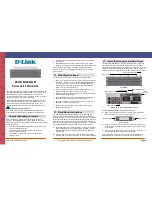
Automatic Server Recovery
ASR is a feature that causes the system to restart when a catastrophic operating system error occurs, such
as a blue screen, ABEND, or panic. A system fail-safe timer, the ASR timer, starts when the System
Management driver, also known as the Health Driver, is loaded. When the operating system is functioning
properly, the system periodically resets the timer. However, when the operating system fails, the timer expires
and restarts the server.
ASR increases server availability by restarting the server within a specified time after a system hang. You can
disable ASR from the System Management Homepage or through UEFI System Utilities.
USB support
Hewlett Packard Enterprise node s support both USB 2.0 ports and USB 3.0 ports. Both port types support
installing all types of USB devices (USB 1.0, USB 2.0, and USB 3.0), but might run at lower speeds in specific
situations:
• USB 3.0 capable devices operate at USB 2.0 speeds when installed in a USB 2.0 port.
• In UEFI Boot Mode, Hewlett Packard Enterprise provides legacy USB support in the preboot environment
before the operating system loading for USB 1.0, USB 2.0, and USB 3.0 speeds.
• In Legacy BIOS Boot Mode, Hewlett Packard Enterprise provides legacy USB support in the preboot
environment before the operating system loading for USB 1.0 and USB 2.0 speeds. USB 3.0 ports can be
used with all devices in Legacy BIOS Boot Mode but are not available at USB 3.0 speeds in the preboot
environment. Standard USB support (USB support from within the operating system) is provided by the
OS through the appropriate USB device drivers. Support for USB 3.0 varies by operating system.
For maximum compatibility of USB 3.0 devices with all operating systems, Hewlett Packard Enterprise
provides a configuration setting for USB 3.0 Mode. Auto is the default setting. This setting impacts USB 3.0
devices when connected to USB 3.0 ports in the following manner:
•
Auto (default)
—If configured in Auto Mode, USB 3.0 capable devices operate at USB 2.0 speeds in the
preboot environment and during boot. When a USB 3.0 capable OS USB driver loads, USB 3.0 devices
transition to USB 3.0 speeds. This mode is compatible with operating systems that do not support USB 3.0
while allowing USB 3.0 devices to operate at USB 3.0 speeds with state-of-the-art operating systems.
•
Enabled
—If Enabled, USB 3.0 capable devices operate at USB 3.0 speeds at all times (including the
preboot environment) when in UEFI Boot Mode. Do not use this mode with operating systems that do not
support USB 3.0. If operating in Legacy Boot BIOS Mode, the USB 3.0 ports cannot function in the preboot
environment and are not bootable.
•
Disabled
—If configured for Disabled, USB 3.0 capable devices function at USB 2.0 speeds at all times.
The pre-OS behavior and default operation of the USB ports is configurable in the UEFI System Utilities. For
more information, see the UEFI System Utilities user guide for your product on the
.
External USB functionality
Hewlett Packard Enterprise provides external USB support to enable local connection of USB devices for
node administration, configuration, and diagnostic procedures.
For additional security, external USB functionality can be disabled through USB options in UEFI System
Utilities.
Redundant ROM support
The node enables you to upgrade or configure the ROM safely with redundant ROM support. The node has a
single ROM that acts as two separate ROM images. In the standard implementation, one side of the ROM
contains the current ROM program version, while the other side of the ROM contains a backup version.
NOTE:
The node ships with the same version programmed on each side of the ROM.
Automatic Server Recovery
183
















































